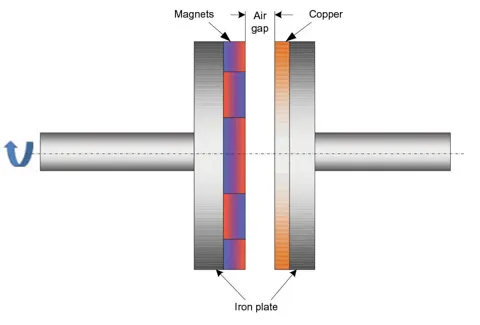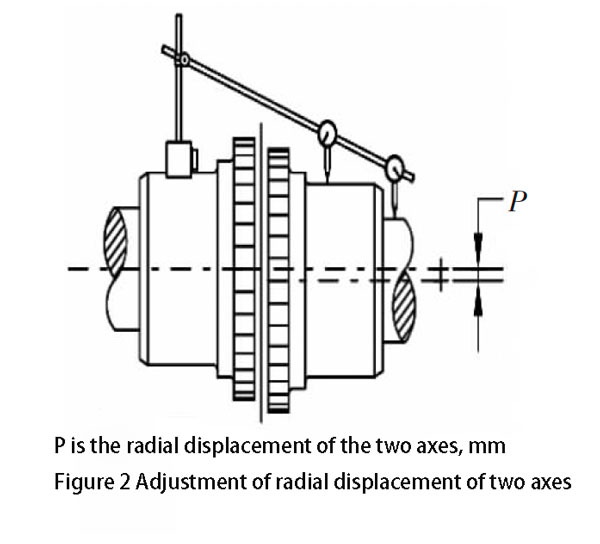non-contact magnetic disc coupling
Non-contact magnetic disc coupling has the characteristics of no mechanical contact, efficient drive, high efficiency and energy saving, simple maintenance, tolerance of large alignment error, long life, etc. It is a new technology that uses modern magnetism as the basic theory and uses the magnetic force generated by magnetic materials to achieve contactless transmission of force or torque. It is a revolutionary drive energy-saving product. Products are widely used in petroleum/petrochemical, natural gas, power generation/thermoelectric, steel, metallurgy, papermaking, central air conditioning, chemical industry, shipbuilding, cement, water supply, water treatment, port machinery and other industries.
Composition of Non-contact magnetic disc coupling
The Non-contact magnetic disc coupling consists of three parts:
- a) The permanent magnet rotor assembly contains permanent magnets and is connected to the load; b) The conductor rotor assembly is connected to the motor;
- c) The actuator assembly is used to control the connection between the permanent magnet rotor and the conductor rotor. Air gap spacing, as shown in Figure 1.
Features of Non-contact magnetic disc coupling
- The daily maintenance workload is extremely small, and it is a maintenance-free product with extremely low operating costs;
- The traditional method of coupling alignment is:
(a) Two-axis radial displacement adjustment is accomplished by adding shims under the motor or reducer base or slightly moving the reducer or motor base as required. The dial indicator is placed on the input shaft of the reducer to the wheel, and can contact the outer diameter of the wheel of the motor output shaft, as shown in Figure 2, when the motor shaft is slowly rotated, the radial displacement can be detected;
(b) The angular displacement calibration of the two shafts is done by measuring the clearance between the two couplings to the end of the wheel on both the horizontal and vertical sides.
The main technical requirements for the assembly of common couplings are very high, as shown in Table 1. Excessive concentricity error will generate additional loads on the coupling, transmission shaft and its bearings, which will result in machine vibration, premature bearing wear, mechanical seal failure, and even fatigue fracture accidents. The Non-contact magnetic disc coupling allows a large installation error, the maximum allowable coaxiality error can be 5 mm, and the angle deviation is 2.07°, which greatly simplifies the installation and debugging process;
c) It has overload protection function, improves the safety and reliability of the whole system, and completely eliminates the damage of the system caused by overload;
d) The magnetic coupler has soft start performance, which improves the motor start ability, realizes the motor soft start or soft stop, and reduces the shock and vibration caused by the instantaneous start of the motor to the equipment;
e) Due to the special structure of the product, the vibrations of the electrical appliances and equipment in operation are not transmitted to each other, which effectively reduces the system vibration and prolongs the service life of the components of the transmission system;
f) The Non-contact magnetic disc coupling has a simple structure, small size, convenient installation and disassembly, and is suitable for working in harsh working conditions;
g) By adjusting the air gap, the torque transmission and speed transmission requirements required by the working machine can be achieved, and the energy saving effect is remarkable;
h) Compared with the hydraulic coupling, the magnetic coupling has a compact structure and no other auxiliary equipment is required for installation. Because the torque is transmitted through the air gap, there is no contact between the two parts, so there are no wearing parts, and can reduce up to 80% of vibration, extending the life of equipment parts and bearings;
i) The stability and comparability are higher than that of frequency conversion, especially in the case of high power; when the load is required, medium and high speed operation is required, and the advantage of replacing the frequency converter is obvious when the power is greater than 50 kW. Compared with the frequency converter, it can eliminate the harmonic interference of the motor, improve the working efficiency of the motor, and the voltage is reduced, the frequency converter may not work, but the device is not affected. When the speed is low, the inverter reduces the motor speed and reduces the efficiency of the cooling fan, which may cause the motor to overheat, but this device does not have this problem.
Table 1 Main technical requirements for a commonly used coupling assembly
| Coupling form | Shaft diameter,mm | End clearance ,mm | Concentricity | Concentricity |
| radial displacement,mm | allowable slope | |||
| Elastic cylindrical pin coupling | φ28~φ150 | 2~8 | 0.14~0.20 | a≤40′ (or allow 0.2mm deviation per 1000mm) |
| Wooden (nylon) coupling | φ18~φ250 | 2~10 | 0.05~0.10 | a≤40′ (or allow 0.2mm deviation per 1000mm) |
| Tooth coupling | φ180~φ560 | 2.5~20 | 0.30~1.00 | a≤30′ |
| Oldham coupling | φ15~φ150 | 0.5~1.50 | 0.10~0.20 | a≤30′ |
| Snake spring coupling | φ15~φ320 | 1.00~4.00 | 0.10~0.50 | Allow 0.1 mm deviation per 1000 mm |
| Flange coupling | φ1~φ180 | – | 0.01~0.02 | Allow 0.5 mm deviation per 1000 mm |
Development of Non-contact magnetic disc coupling
a) The magnetic coupling transmission technology was proposed as early as the 1930s, but due to the lack of understanding of this technology at that time and the limitations of permanent magnet materials, there has been no specific application;
b) In 1946, a British company took the lead in launching a magnetic drive pump, which made the magnetic coupling drive technology begin to have specific applications;
c) In the 1980s, new rare earth permanent magnet materials were developed, which made a breakthrough in the permanent magnet coupling transmission technology and began to enter a period of large-scale application;
d) The U.S. Department of Energy once funded the development of a new permanent magnet coupling drive technology (eddy current magnetic drive technology) for naval ships. Later, it was introduced this technology to the civilian industry in 1999, and there are currently more than 12,000 sets of equipment operate all over the world;
e) In 2008, non-contact magnetic disc coupling technology was introduced into China, which has been successfully used in petroleum, power generation, chemical and other industries;
f) In November 2012, the National Development and Reform Commission proposed to change the name to “Permanent Magnet Eddy Current Flexible Transmission Technology” and “Permanent Magnet Eddy Current Flexible Transmission Technology” after a strict review of the permanent magnet coupling transmission technology, with a single power saving rate of 30%;
4 Conclusion
The magnetic transmission technology has realized a new technological revolution in the history of global transmission, and will definitely bring unprecedented economic benefits to mining business. Because it bring a lot of convenience: energy saving, soft start, and remote control.



